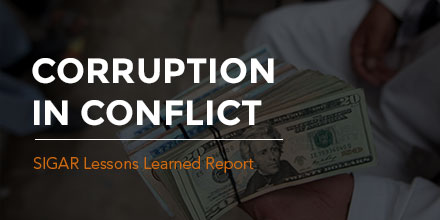Corruption in Conflict: Lessons from the U.S. Experience in Afghanistan

On Wednesday, the Office of the Special Inspector General for Afghanistan Reconstruction (SIGAR) released its first lessons learned report. "Corruption in Conflict: Lessons from the U.S. Experience in Afghanistan" examines how the U.S. government understood the risks of corruption, how the U.S. response to corruption evolved, and the effectiveness of that response.
This is SIGAR’s first interactive, web-based report. This adapted version of "Corruption in Conflict" allows viewers to locate key findings and identify individual points of interest quickly, easily, and from any device.
Report Highlights
-- The United States contributed to the growth of corruption by injecting tens of billions of dollars into the Afghan economy, using flawed oversight and contracting practices, and partnering with malign powerbrokers.
-- The United States helped to lay a foundation for continued impunity of malign actors, weak rule of law, and the growth of corruption.
-- U.S. money was flowing to the insurgency via corruption.
-- People turned to the Taliban as a way of expressing opposition to the government.
-- Malign actors within GIROA support insurgent groups directly, support criminal networks that are linked to insurgents, and support corruption that helps feed the insurgency.
-- To the extent that corruption undermined the state's legitimacy and capability by eroding public confidence in the government and hollowing out institutions, it posed a potentially fatal threat to COIN efforts.
-- Poor U.S. oversight, procurement, and contracting practices were enabling corrupt behavior. Without sufficient controls on U.S. funds, millions of dollars in U.S. reconstruction funds for Afghanistan were being wasted.
-- The Afghan government was so deeply enmeshed in corrupt and criminal networks that dismantling them would mean dismantling major pillars of support for the government itself.
-- One part of U.S. policy corrupted Afghan officials while other parts tried to investigate and root out corruption.
-- Studies suggest that a state's capacity to absorb aid can range from 15 to 45 percent of its GDP. U.S. reconstruction assistance to Afghanistan surpassed 45 percent of Afghanistan's GDP, reaching a high of 105 percent in 2010.
-- Policymakers tended to perceive tradeoffs between fighting corruption and making progress on other important goals. As a result, security and political goals repeatedly trumped strong anticorruption actions. Corruption grew so pervasive and entrenched that it came to pose a threat to the entire security and state-building mission.
-- The U.S. government was forced to choose between maintaining a hard line against corruption or retreating in the face of the realization that fighting corruption would either require even more political capital than anticipated, or be largely futile in the absence of Afghan political will. The U.S. government chose to do the latter.
-- The United States and its international partners wielded great influence in the choices they made about whom to partner with, do business with, and support. Yet the U.S. government supported or tolerated malign powerbrokers who shared a narrow set of U.S. interests and who simultaneously undermined broader, long-term goals.
Remarks
-- While corruption in Afghanistan pre-dates 2001, it has become far more serious and widespread since then.
-- A huge influx of foreign assistance, poor oversight of that assistance, and a willingness to partner with abusive and corrupt powerbrokers increased the opportunities for corruption among Afghans and foreigners alike. It is the endemic corruption that resulted that poses an existential threat to Afghanistan and to U.S. policy objectives.
-- The United States collaborated with abusive and corrupt warlords, militias, and other powerbrokers. These men gained positions of authority in the Afghan government, which further enabled them to dip their hands into the streams of cash pouring into a small and fragile economy.
-- Where the U.S. government is seen as either complicit in or contributing to opportunities for corruption, our legitimacy and credibility, including that of our armed forces, are damaged.
-- Corruption, in other words, is a corrosive acid-partly of our making-that eats away the base of every pillar of Afghan reconstruction, including security and political stability.
-- Failure to effectively address corruption in future contingency operations means U.S. reconstruction programs may, at best, continue to be subverted by systemic corruption, and, at worst, may fail.
Comments
All the more reason to NOT have DoS or USAID involved until AFTER Security is fully established. The Army needs to take responsibility for the post-conflict environment by establish a Military Government. Money can be an adjunct to establishing and maintaining stability, it is not a substitute for security.
